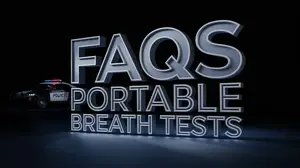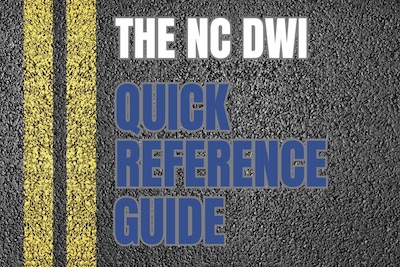North Carolina Alcohol Screening FAQ: PBT Devices, Rules, and Legal Basics
 Law enforcement agencies may use portable breath tests (PBTs) to see if a driver has consumed alcohol. These roadside devices are not the final step in a Driving While Impaired (DWI) case but can help inform an officer’s decision to arrest or proceed with an implied-consent test.
Law enforcement agencies may use portable breath tests (PBTs) to see if a driver has consumed alcohol. These roadside devices are not the final step in a Driving While Impaired (DWI) case but can help inform an officer’s decision to arrest or proceed with an implied-consent test.
North Carolina regulates alcohol screening tests under specific rules in the Administrative Code and relevant statutes, including 10A NCAC 41B .0502 and .0503.
This FAQ addresses key points about alcohol screening in North Carolina, from device approval to practical implications for drivers. It explains how state regulations guide usage, calibration, and recordkeeping. If you have questions about a specific legal matter—or if you want to discuss the impact of a portable breath test—please call or text the Powers Law Firm at 704-342-4357 or email Bill Powers at Bill@CarolinaAttorneys.com.
North Carolina has approved certain portable breath test “PBT” devices for roadside use. These appear on a list maintained by the Forensic Tests for Alcohol Branch, under the Department of Health and Human Services (DHHS). Examples include models such as the Alco-Sensor series (by Intoximeters), the S-D2 or S-D5 (by CMI), and the Lifeloc FC10 (by Lifeloc Technologies). Each device type is evaluated to see if it meets standards for stability, reliability, and acceptable operation. The most commonly used PBT in North Carolina is the Alco-Sensor.
Once a device is approved, law enforcement agencies are authorized to use that specific make and model in roadside scenarios. The Administrative Code, primarily 10A NCAC 41B .0503, references the different screening devices. The approval process involves reviewing the technology, display style (two or three digits), and manufacturer documentation. If a device is not on the approved list, an officer’s use of that equipment might be questioned in a contested DWI proceeding and possibly subject to a motion to suppress.
No. A roadside screening test, sometimes called a PBT or “breathalyzer,” provides a quick indication of whether alcohol is present. It does not replace an evidentiary breath test, which is usually administered on a more sophisticated machine at the station. Under North Carolina’s implied-consent laws (N.C.G.S. 20-16.2), an evidentiary breath test (like the Intox EC/IR II) yields results that can be introduced at trial to show an exact blood alcohol concentration (BAC).
A PBT reading, on the other hand, helps an officer decide if there are reasonable grounds (probable cause) to believe the driver has consumed alcohol and is possibly impaired. The numeric result from a roadside device is generally not used in court to prove an exact BAC level. Instead, the officer may testify about the presence of alcohol or a “positive” indication. This distinction allows the roadside test to function as an investigative tool rather than the final word on impairment.
Calibration helps ensure a portable breath test device measures alcohol vapor accurately. Sensors can drift over time because of temperature changes, age, or mechanical wear. A monthly check helps confirm the device still aligns with a known standard. North Carolina’s rules require that agencies verify calibration at least every 30 days (during periods of active use).
The operator often uses an “alcoholic breath simulator” or an ethanol gas canister. The breath simulator is heated so it produces a vapor with a predictable alcohol concentration. The device should read within a narrow range of that known value. If the reading is off, the operator should remove the device from service or correct the issue. Similarly, gas canisters carry an expiration date, and once that date passes, the canister should not be used for calibration checks.
If calibration records do not show a successful check within 30 days—or if logs are incomplete—the PBT reading the device produces might be questioned later. A defense attorney could argue the machine was out of date and the reading did not reflect the driver’s true condition. The premise is that uncalibrated equipment might inflate or improperly (inaccurately) reflect the alcohol content, which can be relevant to criminal charges other than DUI.
North Carolina rules also address simulator solution changes and gas canister usage. The solution must be replaced every 30 days or after 25 calibration tests, whichever occurs first. Gas canisters should not be used beyond their expiration date. If an officer relies on expired canisters or a questionable simulator solution, a court may doubt whether the purported BAC result is valid or reliable. Operators are directed to keep logs showing each check, date, and outcome in a Test Cannister Log developed by the Forensic Test for Alcohol Division.
North Carolina does not treat a roadside screening PBT as an implied-consent device. That means refusing the preliminary test does not cause an automatic license revocation. However, N.C.G.S. 20-16.3 sets forth that an officer “shall” consider the driver’s refusal when deciding if probable cause exists for an arrest. The refusal may become part of the officer’s written investigation notes, which could be relevant at trial or pretrial motion.
Some drivers choose to submit to a PBT to demonstrate they are not over the legal limit, while others decline because the result is not the final evidentiary number. Either decision is often recorded in the officer's notes, arrest narrative, and/or DWIR - Driving While Impaired Report (review a FREE COPY here in our NC DWI Quick Reference Guide). An officer who observes signs of impairment may proceed with a formal arrest even after a refusal of the PBT, depending on the totality of the circumstances. Screening is a factor, and it should not be the sole basis for prosecution.
A roadside reading indicates whether alcohol is present, but it does not constitute official proof of BAC at trial. Under N.C.G.S. 20-16.3(d), the numeric outcome from a PBT should not be introduced in court to show an exact percentage. Instead, the officer may testify that the device gave a positive or negative result for alcohol. By contrast, an evidentiary breath test—commonly administered on a machine like the Intox EC/IR II—generates a number that may be used as evidence, assuming other procedural rules are met.
This distinction ensures that roadside “breathalyzer” devices remain a quick investigative resource without the detailed process required for an evidentiary test. Checking calibration logs for the portable test can still matter if the driver contends the officer lacked a basis for probable cause to arrest. Even if the actual numeric reading is not cited, the state might mention that a positive screening supported the officer’s suspicion. Defense counsel would be wise to object to the introduction of such evidence under N.C.G.S. 8C-1 (Rule 403 Evidence) as prejudicial and otherwise inflammatory.
Agencies maintain logs of calibration checks, simulator solution changes, and canister replacements. These logs should match the device’s serial number and note the date, time, and result of each verification. Paragraph (e) of 10A NCAC 41B .0503 instructs agencies to use log forms designed by the Forensic Tests for Alcohol Branch and retain them following the agency’s recordkeeping policy. There is no universal statewide retention period, but an agency that discards its logs prematurely may not be able to prove it followed the rules.
In a legal dispute, a defense lawyer may request evidence of calibration. If entries are missing or the device went 45 days without a check, the reported reading might be subject to a motion to suppress given the results could be inaccurate. The agency’s responsibility is to demonstrate it adhered to the monthly schedule, replaced simulator solutions on time, and used canisters before expiration. There are exceptions to this rule, where the Court may in appropriate circumstances allow patterns of practice regarding the proper calibration of PBT devices to be admitted into evidence, allowing the issue to go to the weight of the evidence and not necessarily its admissibility. Each legal matter is unique.
North Carolina’s administrative code 10A NCAC 41B .0502 explains how an officer should administer a roadside test. The main points include verifying the driver has no foreign objects in the mouth (gum, tobacco, etc.) and confirming no recent consumption of alcohol. If the initial reading is .08 or higher, the officer should wait five minutes (or more), then test again. If the second reading differs from the first by more than .02, the officer may disregard the earlier result.
The officer can also request multiple screenings, particularly if the initial reading seems inconsistent with other observations. These steps do not replace the implied-consent test under G.S. 20-16.2, but they may guide an officer during the pre-arrest investigation in deciding whether to place a driver under arrest. Failing to follow mouth checks or waiting periods could raise questions about any result that led to an arrest decision.
Yes, G.S. 20-16.3A covers “checking stations” and roadblocks used to evaluate compliance with Chapter 20 of the NC Motor Vehicle Laws. Are DWI checkpoints legal? An agency must designate a pattern for stopping vehicles and follow guidelines so that no single officer has the discretion to decide what vehicles to stop and which drivers are allowed to pass through a “drunk driving checkpoint.” Upon the vehicle stop, an officer is instructed to look for signs of alcohol consumption at a checkpoint. Thereafter, a roadside test may be administered to confirm or refute the presence of alcohol. Officers may also administer SFSTs - Standardized Field Sobriety Tests.
Officers cannot randomly pick drivers for testing without a set policy. DUI checkpoints (all “checking stations” and roadblocks in North Carolina) must have a legitimate programmatic purpose, such as identifying impaired drivers, rather than arbitrary or discriminatory motives. If a roadside PBT device is used at a roadblock, standard calibration and mouth-check requirements apply just as they do during a regular traffic stop.
Powers Law Firm: DUI Defense Lawyers
 North Carolina’s regulations on alcohol screening devices, calibration intervals, and operator procedures are intended to create a structured, standardized system for roadside tests. Even though the PBT reading is not the final evidentiary number, it can shape whether an officer decides to arrest or investigate further. If logs do not show timely verification, or if the operator failed to wait before retesting, a defense lawyer may review these points for possible inconsistencies.
North Carolina’s regulations on alcohol screening devices, calibration intervals, and operator procedures are intended to create a structured, standardized system for roadside tests. Even though the PBT reading is not the final evidentiary number, it can shape whether an officer decides to arrest or investigate further. If logs do not show timely verification, or if the operator failed to wait before retesting, a defense lawyer may review these points for possible inconsistencies.
If you have questions about a PBT reading or believe calibration steps were missed in your case, call or text the Powers Law Firm at 704-342-4357, or email Bill Powers at Bill@CarolinaAttorneys.com. Evaluating these rules can help reveal how a reported reading was obtained and whether the process complied with North Carolina’s regulatory framework.
 Powers Law Firm PA Home
Powers Law Firm PA Home



















